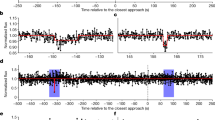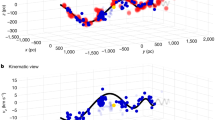Abstract
The ring systems of Saturn and Uranus exhibit several sharp edges across which the optical depth drops from order unity to essentially zero. At least two and perhaps all of these features are associated with the location of orbital resonances between a satellite and the ring particles. It is remarkable that the optical depth varies on a distance scale which is much finer than that over which angular momentum can be transferred between a satellite and the ring material. The important features of this phenomenon are: (1) A perturbed band of width Δa/a ≃ (Ms/Mp)½ adjacent to the edge within which the angular momentum transfer occurs. (2) Streamlines perturbed such that the angular momentum luminosity decreases smoothly across the band to zero at the edge even though the optical depth remains constant. (3) Dynamical equilibrium requires a relation between the random velocity, the rate of deformation and the optical depth
This is a preview of subscription content, access via your institution
Access options
Subscribe to this journal
Receive 51 print issues and online access
$199.00 per year
only $3.90 per issue
Buy this article
- Purchase on Springer Link
- Instant access to full article PDF
Prices may be subject to local taxes which are calculated during checkout
Similar content being viewed by others
References
Smith, B. A. et al. Science 212, 163 (1981).
Elliot, J. L., Dunham, E., Wasserman, L. H., Millis, R. L. & Churms, J. Astr. J. 83, 980 (1978).
Lane, A. L. et al. Science 215, 537 (1982).
Holberg, J. B., Forrester, W. T. & Lissauer, J. J. Nature 297, 115–120 (1982).
Smith, B. A. et al. Science 215, 504 (1982).
Goldreich, P. & Tremaine, S. Icarus 34, 240 (1978).
Borderies, N., Goldreich, P. & Tremaine, S. (in preparation).
Goldreich, P. & Tremaine, S. Icarus 34, 227 (1978).
Lynden-Bell, D. & Pringle, J. E. Mon. Not. R. astr. Soc. 168, 603 (1974).
Lin, D. N. C. & Bodenheimer, P. Astrophys. J. Lett. 248, L83 (1981).
Lukkari, J. Nature 292, 433–435 (1981).
Ward, W. R. Geophys. Res. Lett. 8, 641 (1981).
Goldreich, P. & Tremaine, S. Astrophys. J. 241, 425 (1980).
Author information
Authors and Affiliations
Rights and permissions
About this article
Cite this article
Borderies, N., Goldreich, P. & Tremaine, S. Sharp edges of planetary rings. Nature 299, 209–211 (1982). https://doi.org/10.1038/299209a0
Received:
Accepted:
Issue Date:
DOI: https://doi.org/10.1038/299209a0
This article is cited by
-
Science Goals and Mission Objectives for the Future Exploration of Ice Giants Systems: A Horizon 2061 Perspective
Space Science Reviews (2021)
-
Cassini Imaging Science: Instrument Characteristics And Anticipated Scientific Investigations At Saturn
Space Science Reviews (2004)
-
Generalized theory of impacts in particulate systems
Earth, Moon, and Planets (1993)
-
Ring dynamics
Celestial Mechanics and Dynamical Astronomy (1989)
-
Lorentz resonances and the structure of the Jovian ring
Nature (1985)
Comments
By submitting a comment you agree to abide by our Terms and Community Guidelines. If you find something abusive or that does not comply with our terms or guidelines please flag it as inappropriate.



